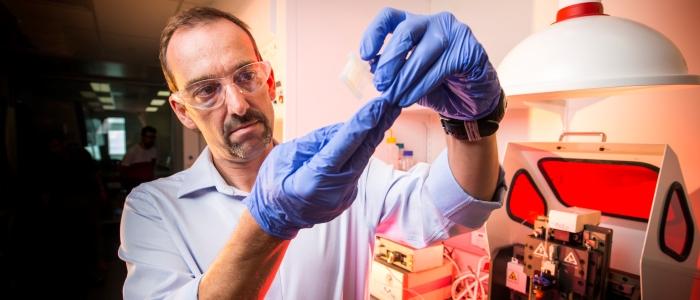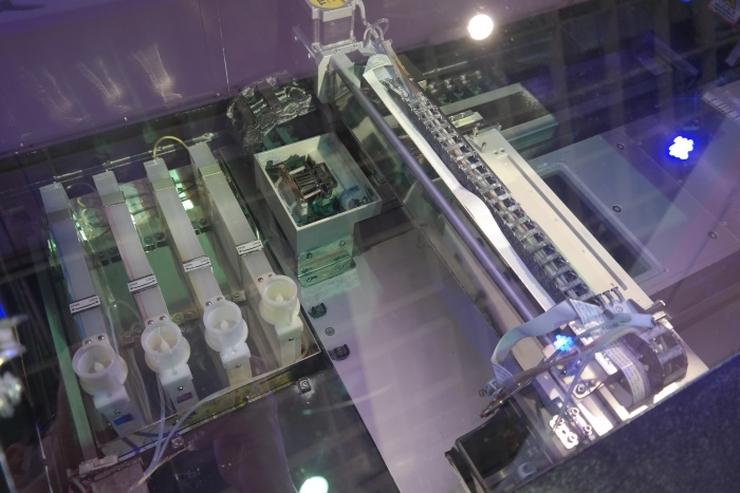 It may seem a touch misleading in name, but scientists at the University of Wollongong say they’re creating what they call 4D printing. The fourth dimension they refer to is time and shape shifting as the researchers have begun to develop 3D printed materials capable of morphing into new structures – post production – as those materials are influenced by the addition of external stimuli such as water or heat.
It may seem a touch misleading in name, but scientists at the University of Wollongong say they’re creating what they call 4D printing. The fourth dimension they refer to is time and shape shifting as the researchers have begun to develop 3D printed materials capable of morphing into new structures – post production – as those materials are influenced by the addition of external stimuli such as water or heat.
 The team at the ARC Centre of Excellence for Electromaterials Science say these new materials are able to transform themselves from one shape into another, and they see applications for them in medical soft robotics.
The team at the ARC Centre of Excellence for Electromaterials Science say these new materials are able to transform themselves from one shape into another, and they see applications for them in medical soft robotics.
This technique and materials combination was used to fabricate a valve which actuates in response to the temperature of any water surrounding it.
“The cool thing about it is, it’s a working, functioning device that you just pick up from the printer,” says ACES Professor Marc in het Panhuis. “There’s no other assembly required.”
The valve, a 3D printed structure, includes the actuators, and they’re activated solely by the introduction of water.
The “smart valve” is created by the 4D printing of hydrogels that are both mechanically robust and thermally actuating, and they’re made of an interpenetrating network of alginate and poly N-isopropylacrylamide. These ‘4D’ structures are created by printing the “dynamic” hydrogel ink alongside other static materials used to fabricate the device.
“It’s an autonomous valve,” Panhuis says. “There’s no input necessary other than water; it closes itself when it detects hot water.”
As the ACES Chief Investigator, Panhuis says his group was the first to combine the printing a 4D device with four different cartridges at once. The process uses the tough hydrogels – fiber reinforced in a single-step process – and these composite materials were fabricated using a combination of a alginate-acrylamide gel precursor solution and an epoxy based UV-curable adhesive known as Emax 904 Gel-SC.
Panhuis says his main research focus is to combine bio and synthetic polymers with carbon nanostructures, and or conducting polymers via processing techniques such as additive fabrication into soft (wet and tough) materials for water treatment, soft robotics, bionics and tissue engineering applications.
The authors of the paper that the team published on the research, 4D Printing with Mechanically Robust, Thermally Actuating Hydrogels, were Shannon Bakarich, Doctor Robert Gorkin III, Panhuis and Professor Geoff Spinks.
 What do you think of the concept of ‘4D’ printing and these kinds of structures which can react to changes in temperature or exposure to liquids? Let us know in the 4D Printed Valve forum thread on 3DPB.com.
What do you think of the concept of ‘4D’ printing and these kinds of structures which can react to changes in temperature or exposure to liquids? Let us know in the 4D Printed Valve forum thread on 3DPB.com.
Subscribe to Our Email Newsletter
Stay up-to-date on all the latest news from the 3D printing industry and receive information and offers from third party vendors.
You May Also Like
High Stakes, High Speed: KVG Acquires 15 Nexa3D HSE 3D Printers to Boost Military Tech
As 3D printing increasingly intersects with defense and military logistics, a new partnership between Nexa3D and mission support logistics firm KVG stresses the growing importance of this technology in strategic...
3D Printer Maker EVO-tech Reborn as NEVO3D — Once More With Feeling
EVO-tech was a 3D printing service and original equipment manufacturer established in 2013 and based in Schörfling am Attersee, Austria. The company produced high-quality material extrusion systems featuring linear bearings,...
3D Printing News Briefs, March 16, 2024: Partnerships, Affordable Bioprinter, & More
We’re starting with dental 3D printing news today, and then moving on to some new partnerships. Then it’s on to some interesting university research about 3D printing plant-based pharmaceuticals, but...
FDR vs. SLA: The Right Polymer Manufacturing Choice for Your Application
The additive manufacturing (AM) industry has no shortage of acronyms when it comes to the various methodologies of industrial 3D printing. In polymer 3D printing, there are three main methods...































